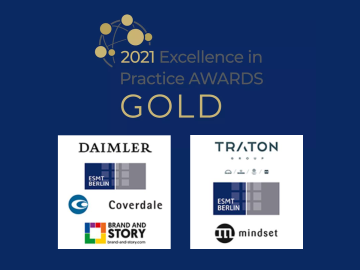The Client
In 2018, Volkswagen Truck & Bus was renamed Traton. Now traded on the Frankfurt and Stockholm stock exchanges, Traton is a subsidiary of the Volkswagen Group, and it is one of the largest commercial vehicle manufacturers in the world, with the brands MAN, Scandia, Rio, Volkswagen Caminhões e Ônibus and, most recently, Navistar in its portfolio. As of Dec. 31, 2020, the group had around 83,000 employees; that year, the group sold 190,180 units, including light-, medium-, and heavy-duty trucks and buses.
The Challenge
Traton has set itself the goal of becoming the world leader in transportation services — the sector’s “global champion.” With this goal in mind, it has developed a Global Champion strategy, and it has established a talent development strategy to further this effort. The Global Champion strategy seeks to create sustainable shareholder value, with a focus on brand performance, cooperation and synergies, global expansion, and customer-focused innovation.
The program seeks to encourage participants to develop cross-brand skillsets, improve cooperation, and nurture a global mindset. Its key objectives are creating cross-brand top talent exchange, ensuring talent visibility at the group level, and imparting critical skills for achieving the global leader role.
Fulfilling this mission depends upon Traton’s brands being able to successfully discover and take advantage of strengths in common. A new Management Excellence program was developed to enable brand managers to drive business success through intrapreneurship — that is, an entrepreneurial approach within an established company — as well as a disruptive mindset and critical data consumption.
The Commitment
The cross-brand program team quickly identified four crucial features that any successful program would have to have:
- Cutting-edge content that would equip Traton brand managers with the latest thinking, skills, tools, and approaches to enable cross-brand intrapreneurship and critical data consumption.
- Cutting-edge educational design that considered the program not as a series of events but as a journey that would support and guide learners to apply what they would learn in impactful ways.
- Feedback dynamics that were well thought out and that provided opportunities to share challenges and successes.
- Guided application of lessons learned, using the above as tools to bring the theory into practice.
Traton partnered with Mindset, a Swedish training company with over 20 years of experience turning learning into action. It also partnered with ESMT Berlin, whose world-class faculty would contribute the best educational resources available. This collaboration began with full-day workshops at the three organizations’ headquarters: Traton in Munich, ESMT in Berlin, and Mindset in Stockholm. These built a foundation of trust, a shared vision, and a clear idea of how Traton would benefit.
The Learning Design
As the program team worked together on the program design, one of the first documents to be produced was the Impact Map, a four-column document that described how lessons learned would be applied on the job to bring about desired results.
The program team set out a 10-month journey that would provide participants with necessary knowledge and skills, safe practice opportunities, and guidance on using these skills in their work. A three-layer approach emerged:
- The learning layer was modeled on the principle of converging and diverging thinking. Before each of the synchronous interventions (“labs”), participants were provided with a series of assignments designed to build a common knowledge foundation (converging). The labs then introduced multiple concepts and provided an environment to share perspectives and try out new skills, guided by ESMT Berlin faculty (diverging).
- The behavioral change layer was the link between learning and impact. The centerpiece of this layer was the “Application Challenges,” which provided participants with a choice of concrete ways to use the skills they had practiced during the lab. Each participant was required to identify, carry out, and report back on the three most relevant and valuable challenges for them in their role.
- The third and final layer was the support layer. To make a lasting transition from learning to sustained application, participants would need feedback, encouragement, and support. This layer leveraged multiple relationships—faculty, program peers, team members, and supervisors—to provide the support, feedback, and accountability needed.
The three-layer design created a seamless and cohesive 10-month journey that was integrated into each participant’s job role. The program team used the Promote® online learning platform to distribute learning materials such as case studies, videos, and knowledge packs; support social learning; create participant accountability and get real-time information on program success.
When COVID-19 first forced lockdowns in March 2020, the Learning and Development community was forced to reappraise training delivery methods and delivery channels. TRATON briefly considered pausing the program, but quickly determined that they would continue.
The program had a good head-start for making the transition to a virtual learning journey. Promote provided a perfect means for distributing program content, as well as a two-way communication channel to broadcast program updates as the pandemic developed. In addition, online check-in sessions had already been built-in as part of the original program design. These sessions were painlessly re-purposed as virtual classes.
The virtual classes themselves presented both participants and faculty with a steep learning curve. But organizers quickly acted on participant feedback, so break-out rooms, chat pods, and Mentimeter polls soon became standard tools for delivering engaging virtual sessions.
The Impact
Participant data gathered both during and at the end of the program identified very high levels of carryover from training to practical application.
In particular, every single participant effectively implemented the skills of “establishing an open error culture” and “using elements of a good decision to combine rationality and debiasing.” And nearly 90 % of the participants agreed that although they may have been practicing some of the taught behaviors before attending Management Excellence, after attending the program, they were doing so much more consciously, deliberately, and proficiently.
Some of the key lessons that the organizers learned include:
- Invest time to build trust at the front end. The initial workshops were critical for building trust and respect for each partner’s strengths and a common goal for the whole program.
- Use virtual classes to deliver just-in-time learning. Virtual classes can be a useful way of breaking content down into smaller bite-size chunks, convenient for the busy managers that make up the target audience.
- Use weekly pulse meetings. These build a strong culture and keep the program on track. At first, their primary function was to keep the program and the participants on track, but they evolved into important opportunities for maintaining team spirit.
The program team is very proud of its members’ accomplishments, and the client is very satisfied with the program’s results.
International recognition
EFMD Award 2021
EFMD, Europe’s largest network association for management development, has given the ESMT Berlin customized executive education programs with Traton the Gold Excellence in Practice (EiP) Award.
About the award
EFMD is an international non-profit association and Europe's largest network association in the field of management development, with member organizations from academia, business, public service, and consultancy.
Its Excellence in Practice (EiP) Awards recognize outstanding and impactful client-supplier partnerships in the domains of leadership, professional, talent, and organizational development.
Embark on a learning journey with ESMT Custom Programs
ExecEd Ranking 2024
ESMT Berlin is once again the top provider of executive education in Germany and #8 globally for customized programs, according to the 2024 Financial Times Executive Education ranking.


